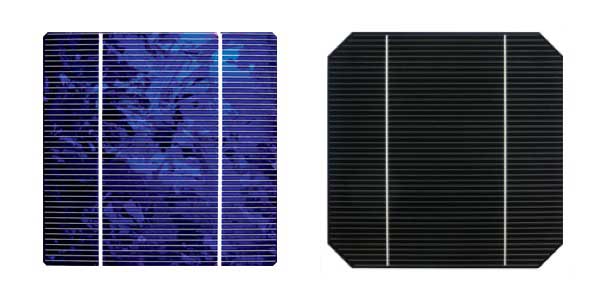Polycrystalline vs Monocrystalline Solar Panels
By Finn Peacock, Chartered Electrical Engineer, Fact Checked By Ronald Brakels

A polycrystalline and a monocrystalline solar cell: used to make poly and mono solar panels respectively.
What is the better photovoltaic solar panel technology for Australian conditions? Poly or mono?
Generally the answer depends on which solar salesman you speak to. If he’s selling polycrystalline (aka multicrystalline), surprise, surprise – poly is the best. If he’s selling monocrystalline panels then… well, you get the picture.
Here’s the truth. When comparing mono and poly panels of the same rated power output, there is currently no practicable difference in the performance of these two technologies. The only difference worth knowing is that if you are dead set on buying the highest efficiency panel on the market, the most expensive, highest watt panels are monocrystalline. But the only advantage of a more efficient solar panel is that you can get more watts on your roof. If you can fit the system size you need on your roof with more affordable, less efficient panels, then there is no difference between mono and poly.
To make my point, let’s compare the specs of 2 similarly priced, good quality solar panels that were available in Australia in 2019, one polycrystalline and one monocrystalline.
Polycrystalline: Trina Allmax P 275
Monocrystalline: Trina Allmax M 275
|
Spec |
Poly Panel |
Mono Panel |
|
Efficiency |
16.8% |
16.8% |
|
Temperature Coeff |
-0.32 %/°C |
-0.29%/°C |
|
Performance Ratio |
89.9% |
89.9% |
Efficiency: No difference.
Temperature coefficient: This is a measure of how much the power drops when the module gets hot (solar panels like light, but don’t like heat). The mono solar panel is a bit better according to the manufacturer’s spec: -0.03%/°C better.
But bear in mind that this specification is notoriously unreliable if you rely on the manufacturers to measure it! And even if it is accurate, this would mean that the monocrystalline panel would only produce 1% more power than the poly module if both panels were at 65°C. Not enough to worry about in my opinion.
Performance Ratio: This is the most important spec in my opinion. That’s because the number comes from an independent test commissioned by the California Energy Commission, not from the manufacturers. It shows how much power the panel will produce in real world conditions compared to the manufacturer’s specification. As you can see, the polycrystalline panel is the same as the monocrystalline.
So there you have it; when it comes to mono vs poly – don’t worry about it – just select a good brand with an Australian presence, good warranties and a good performance ratio. Learn more about how to choose a good PV module and how much solar panels cost, or check out our solar panel reviews section.
You can also see how a bunch of modules currently available in Australia stack up side by side in terms of specifications and cost using our solar panel comparison table.
